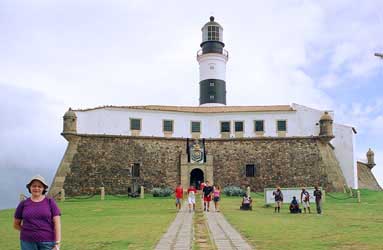 |
For a long time, we had been dreaming with a visit to Bahia and its capital, Salvador. And when finally we got there, it was not what we expected, it was much better. Salvador was the first major port and the capital of colonial Brazil for almost two centuries, and even today, nothing in Brazil, in terms of exotic places, history, ancient culture, traditions and music compares to it. Salvador is one of those places apart from everything you have seen before. The photo at left was shot next to Farol da Barra light house, maybe the most famous landmark of this unique place, called Salvador. |
A very special part of a visit to Salvador is dedicated to its many colonial churches. People use to say that there are 365 churches in town, but actually there are not so many. Start you tour visiting Igreja de São Francisco (right). Built from 1708 to 1750, the inside walls are totally covered with gold, making this a very impressive sight. Visit also Cathedral Basilica, located at Terreiro de Jesus, built from 1657 to 1672, in the upper part of Pelourinho hill, which gave the Portuguese priests and soldiers, total control over the Todos os Santos Bay, and helped them watch any enemy ship approaching, like the Dutch or French. |
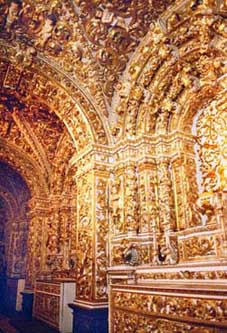 |
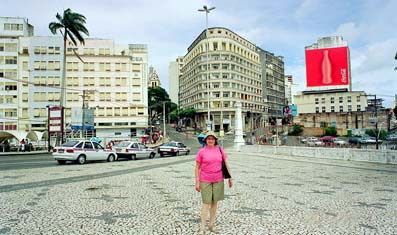 |
Salvador has about 2 million inhabitants. According to the most recent population census, it is the 3rd largest city in Brazil. Most of Salvador's residents are of African descent. The main religions are Catholicism, Candomble, Protestantism, and Spiritism. The most characteristic feature of Salvador's religious life is known as syncretism. In the last century the city expanded into the still elegant areas of Barris and Canela to the south of Cidade Alta, and up to the exclusive residential suburb of Barra. At left, photo taken downtown. |
Salvador was built on two levels: On the upper level were located the main offices, administrative buildings and the rich people. On the lower level were located the docks, the warehouses, the port and the poor people, a model brought from Europe by the Portuguese. Also, do not miss at Pelourinho, Fundacao Casa de Jorge Amado (Jorge Amado House, one of the most famous novelists in Brazil) and Museu da Cidade (City Museum), both located at the Pelourinho main square. |
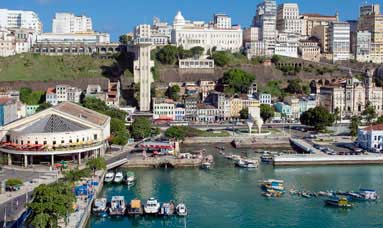 |
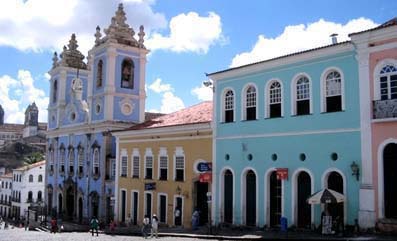 |
If you don't have much time to visit the city, don't think twice, the right place to be is at Pelourinho (left). It is the heart of the Old Salvador, filled with colonial buildings, winding cobblestone streets, music, bars, churches, restaurants, museums and souvenirs shops. This is actually a city within a city. Pelourinho means whipping post in Portuguese, and this was the old slave auction location in the days when slavery was common. In the 1990's, a major restoration effort resulted in making the area a highly desirable tourist attraction. |
Salvador cuisine is a mix of Brazilian and African cuisines, with an abundant use of the coconuts, ginger, shrimp, spices and flavorful dende oil, made from palms. Hot peppers and strong spices are usual in almost every dish. Be aware when ordering a meal that a hot meal means very spicy and a cold meal means without pepper or spices. At right, a shot of Patamares Beach. From this point, a coastline of coves and beaches, large and small, is linked by the twisting Oceanica Ave, which runs along the shore through Ondina, Rio Vermelho and Pituba, the main beach areas.
At right, again, Pelourinho area, the heart of historic Salvador. In many restaurants and even on the streets you'll probably find ladies all dressed in white, offering assortment of Bahia's dishes. They are called Baianas, and their outfit, as well as their dishes, is part of the ancients traditions brougth from Africa. |
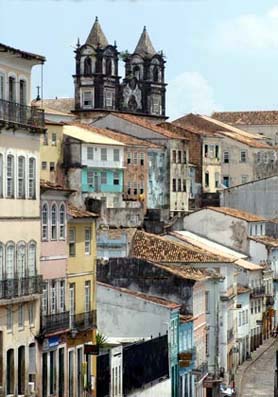 |
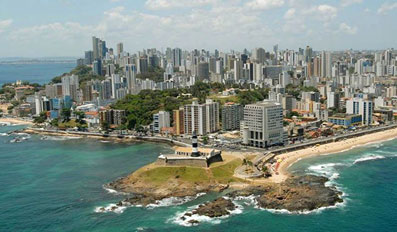 |
At left, an aerial view showing Salvador downtown, and, over the rocks, Farol da Barra lighthouse, maybe the most famous Salvador lankmark. |
One more shot at some of the many Pelourinho's hills, in front of a cozy restaurant. Nicknamed Pelo by residents this area is in the older part of the Upper City (Cidade Alta), located on the hills, which is opposite to the Lower City (Cidade Baixa), in front of the sea. Pelourinho encompasses several blocks around the triangular Largo do Pelourinho, the central square. It is a specially interesting area at night, due to the many music groups that use to practice along the streets, performing traditional rythms, music and dance, like Berimbau, Afoxe, Olodum and Capoeira, all of them brought from Africa by the slaves during the 17th and 18th centuries. |
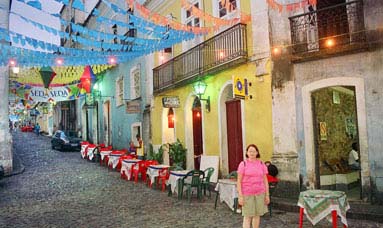 |
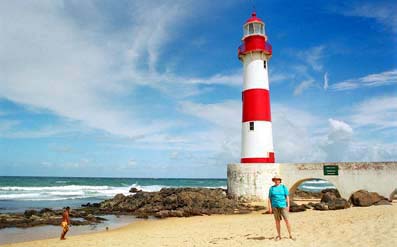 |
Photo from Farol de Itapoan (Itapoan Lighthouse), located some 15 miles north of downtown. Those who enjoy shopping have many options, apart from the shops at Pelourinho, at Salvador's three large malls: Shopping Iguatemi (the largest in town), Shopping da Barra (centrally located, next to the main hotels and the beach), and Aeroclube Plaza Show (open air mall, located north). |
Salvador is still divided into upper and lower cities, and the main link among the two parts is Elevador Lacerda (right), a huge lift that carries thousands of people up and down every day. Beyond, you can see Todos os Santos Bay, the harbor, and just behind the lift base, the Mercado Modelo Market, best place in town to find souvenirs, artcraft, musical instruments and try some exotic dishes from Bahia, like Vatapa, Acaraje, Abara, Moqueca, Bobo and much more. |
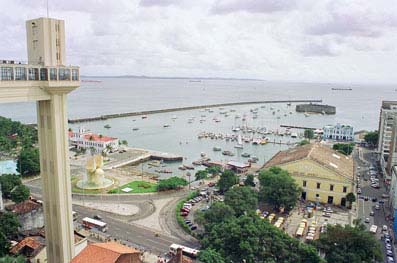
|
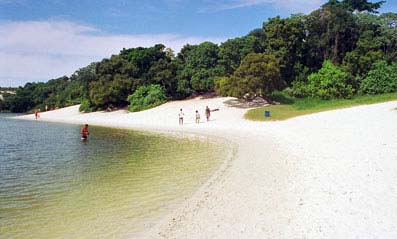 |
Lagoa do Abaete is famous for its crystal water and soft white sands. Located north Salvador, is one of the most famous spots of town. Next to it there is a nice restaurant, with live music at night. There is, indeed, a large number of restaurants serving Bahia traditional dishes in town, buy maybe the most famous is Restaurante da Dada, a wonderful place almost inside the ocean, at Patamares beach, north Salvador. At night, visit Solar do Unhao, a great restaurant with delicious meals and live music and dance performed by traditional dancers from Bahia. |
A short walk south of Farol da Barra, we found this old canons, ramaining parts or an old portuguese fort. |
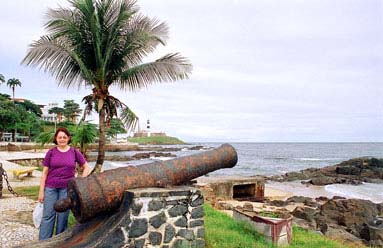 |
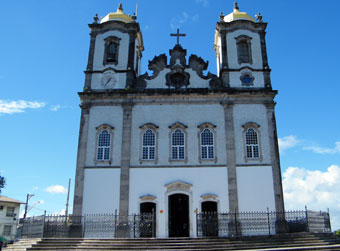
|
At left, Nosso Senhor do Bonfim Church, Salvador's most famous lankmark. Everyone visiting town should includ this one on the tour. It is not the larger or the most beautiful church of town, but it is for sure the most famous one. |
Photo from Humaita Fort, located some 10 miles south of Salvador. It was built by the portuguese, and now is open to visitors as an touristic attraction. Not far from here you will find the most famous church in town, the Igreja do Bonfim. When arriving there you will be surrounded by children selling fitas, small colored ribbons, to tie around your wrist inside the church when you make your requests. Take plenty of them, to you and your friends at home. Locals say if must wear one of those ribbons around your wrist until it falls down, when finally that long waited dream of yours will come true. |
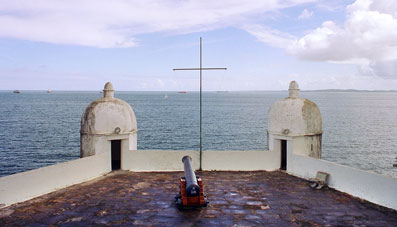
|
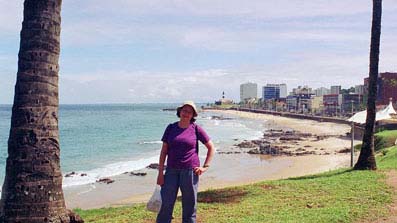
|
Like no place else in Brazil, Bahia brings together a unique mix of history, art, culture, music, architecture... This is a place to visit over and over again, because just one won't be enough to meet all its beauties. As people use say here, Bahia is the land of happiness, and this is something you won't see, but will surely feel. |

A traditional Baiana, all dressed in white
|
|